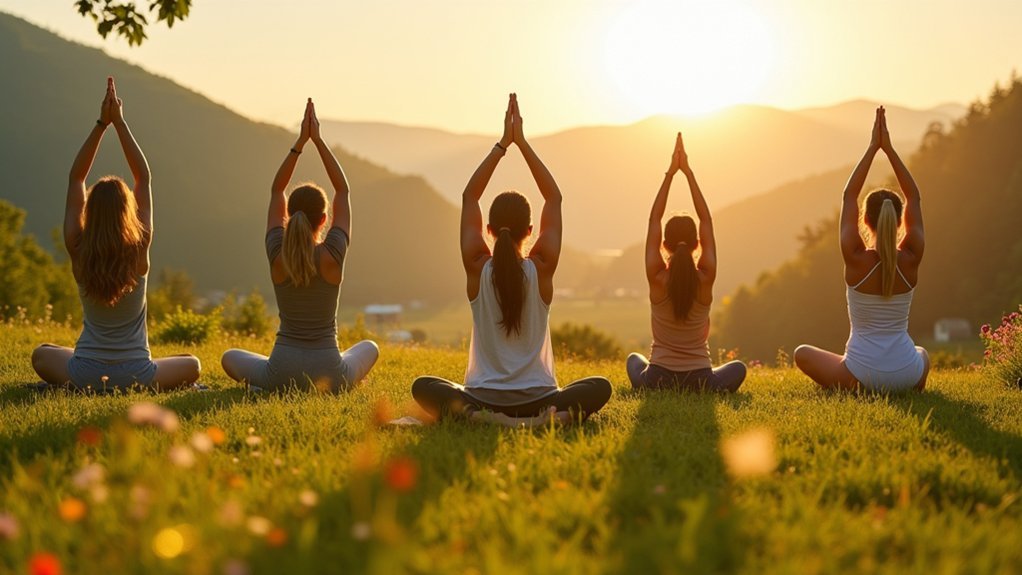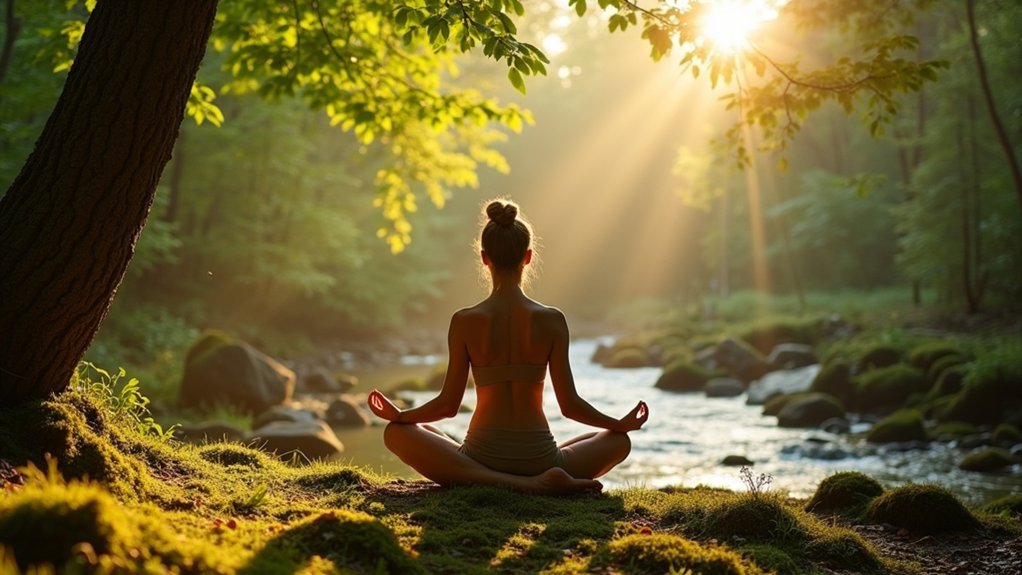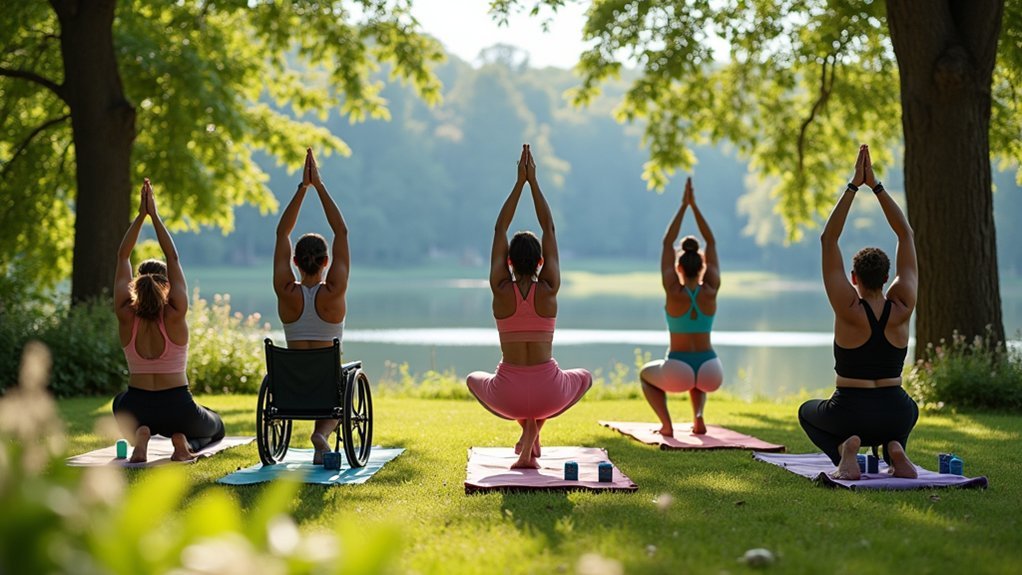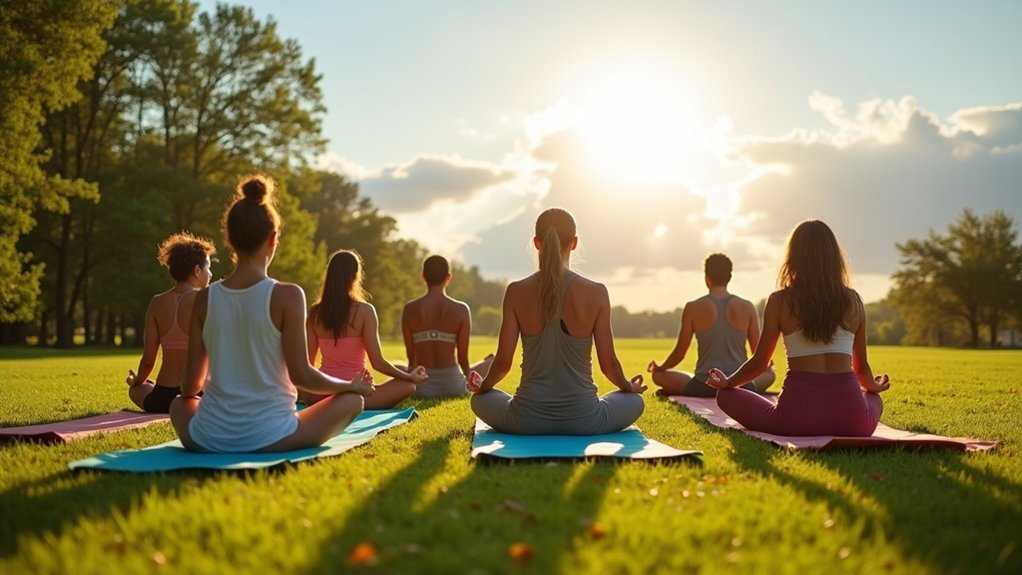Outdoor yoga soothes persistent pain by combining two powerful natural therapies. You’ll benefit from nature’s ability to dampen pain signals while simultaneously improving your mood. The fresh air enhances breathing capacity, while natural surfaces challenge your balance and strengthen core muscles. Sunlight boosts vitamin D production, and “earthing” reduces inflammation. The supportive community aspect validates your pain journey and provides motivation. Discover how this synergistic approach can transform your relationship with chronic discomfort.
The Science Behind Nature’s Healing Effect on Chronic Pain

While many still rely on medication for pain relief, emerging research reveals that nature exposure therapy offers a compelling alternative for chronic pain management.
Brain imaging studies show that natural environments actually alter your neurobiological pathways, reducing pain perception at its source.
Nature rewires your brain’s pain circuits, offering relief where it matters most.
When you immerse yourself in nature, your brain responds by dampening pain signals while simultaneously improving your mood. This dual effect targets both the physical and psychological aspects of chronic pain.
You’ll likely experience decreased pain intensity alongside reduced anxiety and depression—common companions to persistent pain conditions.
The outdoor environment also encourages physical activity, providing a welcome distraction from discomfort while enhancing your overall quality of life.
These benefits offer a promising non-pharmacological approach that avoids the risks associated with long-term medication use. Studies demonstrate that patients with views of natural elements like trees and water required significantly less pain medication compared to those exposed to built environments.
How Outdoor Elements Enhance Yoga’s Pain Relief Benefits
Moving from understanding nature’s neurobiological effects to practical application, yoga becomes substantially more powerful when practiced outdoors.
When you practice yoga on grass or soil, “earthing” helps reduce inflammation and improve cardiovascular health—directly affecting your pain levels. The physical connection with the ground provides numerous benefits, including relieving body pain through natural grounding. The sunlight you absorb boosts vitamin D production while regulating your circadian rhythms, improving sleep quality that further reduces pain sensitivity.
The natural environment challenges your balance differently than indoor floors, strengthening your core muscles while heightening physical awareness and improving alignment.
Fresh air deepens your breathing capacity, while the sensory richness of nature amplifies mindfulness, helping you focus on breath rather than discomfort.
These elements work synergistically—the stress reduction from both yoga and nature exposure creates a powerful anti-inflammatory effect that can substantially decrease chronic pain while enhancing your overall sense of well-being.
Adapting Yoga Poses for Different Pain Conditions in Natural Settings

Adapting yoga practices for different pain conditions requires thoughtful modifications that respect both your body’s limitations and the unique outdoor environments where you practice.
For chronic back pain, embrace gentle Cat-Cow sequences and supported Bridge poses using logs or rocks as natural props. If you’re managing arthritis, try Iyengar-style adaptations on elevated surfaces like benches to reduce joint stress, and strategically use morning sunshine for natural warmth.
With fibromyalgia, prioritize restorative positions on soft grass and incorporate calming breath work to manage pain perception. Sessions typically last between 45 to 90 minutes, though practicing at home for shorter periods can also provide benefits.
Embrace the earth’s cushion beneath you while gentle breath rhythms quiet the sensitive nervous system.
For neck and shoulder tension, utilize trees for supported shoulder openers. Remember to shift mindfully between poses—research shows that even virtually-guided outdoor yoga can reduce pain intensity by 1.5-2.3 points after consistent practice.
Building a Supportive Outdoor Practice Community for Pain Management
The healing journey through chronic pain doesn’t have to be walked alone. When you practice yoga outdoors with others facing similar challenges, you’ll find both physical relief and emotional support that amplifies your pain management efforts. Research shows that yoga can significantly improve back-related function for those with chronic low back pain, making group practice especially valuable.
| Community Benefit | How It Helps Your Pain |
|---|---|
| Shared Experience | Reduces isolation and validates your pain journey |
| Knowledge Exchange | Learn adaptive techniques specific to your condition |
| Consistent Motivation | Improves adherence through group accountability |
Outdoor settings naturally increase accessibility—no expensive equipment or memberships required. You’ll benefit from instructor guidance while developing connections with others who understand your struggles. This combination of social support and skill-building in nature creates a powerful foundation for long-term pain relief that extends well beyond individual practice.
Accessible Outdoor Yoga: Equipment and Modifications for All Abilities

Accessible outdoor yoga isn’t limited by physical ability—it welcomes every body through thoughtful equipment choices and smart modifications.
Yoga blocks, stretching bands, and wedges can transform challenging poses into achievable ones, while specialized mats provide stability on varied terrain.
Simple props turn the impossible into possible—your body’s journey becomes uniquely yours on nature’s uneven stage.
For mobility concerns, consider chair yoga or wall-assisted poses using nearby trees or structures.
Practice on level ground in shaded areas, with mat anchors for uneven surfaces. Partner support offers both safety and community connection during balance work.
Instructors trained in adaptive techniques can guide you through modifications tailored to your needs.
Many outdoor programs now offer mobility rentals and adaptive aids, ensuring everyone can experience nature’s healing benefits. The Multi-Loop Yoga Strap provides pre-looped slots for easier transitions between poses outdoors.
Look for classes with smaller sizes that provide personalized attention and create a welcoming environment.
Frequently Asked Questions
Can Outdoor Yoga Worsen Certain Chronic Pain Conditions?
Yes, outdoor yoga can worsen your chronic pain if you have heat intolerance, photosensitivity, or joint conditions. Weather fluctuations and uneven surfaces might strain your body, and allergens could trigger inflammation.
How Does Weather Affect Pain Relief Benefits During Outdoor Yoga?
Weather greatly impacts your pain relief during outdoor yoga. Cold increases stiffness, while warmth relaxes muscles. Barometric pressure drops can worsen pain, and extreme humidity affects joint comfort. Choose moderate conditions for best results.
What Time of Day Is Most Effective for Pain-Relieving Outdoor Yoga?
The most effective time for pain-relieving outdoor yoga is when you’ll practice consistently. Morning sessions boost energy and align with circadian rhythms, afternoon breaks reduce accumulated tension, and evening practice enhances sleep quality and recovery.
Is Indoor or Outdoor Yoga More Effective for Severe Pain?
Neither indoor nor outdoor yoga is definitively better for severe pain. You’ll likely benefit from both, but outdoor settings may offer additional advantages through nature exposure, earthing, and sunlight that complement yoga’s pain-relieving effects.
How Long Before Outdoor Yoga Practice Shows Measurable Pain Reduction?
You’ll likely experience measurable pain reduction within 8-12 weeks of regular outdoor yoga practice. Some people notice initial improvements earlier, often by week 6, especially when practicing 2-3 times weekly with proper technique.
In Summary
You’ve now explored how nature and yoga create a powerful combination for managing your persistent pain. By taking your practice outdoors, you’re engaging multiple healing mechanisms—from vitamin D exposure to mindfulness amplified by natural surroundings. Don’t wait for perfect conditions; start with even five minutes in your backyard. Your body and mind will thank you as you build this sustainable, medication-free approach to pain relief.





Leave a Reply